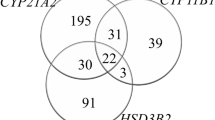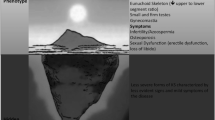Abstract
Genetic alterations frequently are involved in the development of a pituitary adenoma in young age. We here characterize the functional role of a deletion in CDKN1B 5′-UTR region (c.-29_-26delAGAG) identified in an acromegalic patient that developed a growth hormone in pituitary adenoma during childhood. Our results show that the identified novel heterozygous deletion in the CDKN1B 5′-UTR region associates with a reduction in CDKN1B mRNA levels, a predicted altered secondary mRNA structure, and a reduced CDKN1B 5′-UTR transcriptional activity in vitro. The patient displayed loss of heterozygosity in the same CDKN1B 5′-UTR region at tissue level and the 5′UTR region containing the deleted sequence encompasses a GRE. These findings indicate that the identification of functional alterations of newly discovered genetic derangements need to be fully characterized and always correlated with the clinical manifestations.

Similar content being viewed by others
References
A.F. Daly, M. Rixhon, C. Adam, A. Dempegioti, M.A. Tichomirowa, A. Beckers, High prevalence of pituitary adenomas: a cross-sectional study in the province of Liege, Belgium. J. Clin. Endocrinol. Metab. 91, 4769–4775 (2006)
A. Fernandez, N. Karavitaki, J.A. Wass, Prevalence of pituitary adenomas: a community-based, cross-sectional study in Banbury (Oxfordshire, UK). Clin. Endocrinol. (Oxf) 72, 377–382 (2010)
N.S. Pellegata, L. Quintanilla-Martinez, H. Siggelkow, E. Samson, K. Bink, H. Hofler, F. Fend, J. Graw, M.J. Atkinson, Germ-line mutations in p27Kip1 cause a multiple endocrine neoplasia syndrome in rats and humans. Proc. Natl. Acad. Sci. 103, 15558–15563 (2006)
M. Lee, N.S. Pellegata, Multiple endocrine neoplasia syndromes associated with mutation of p27. J. Endocrinol. Invest. 36(9), 781–787 (2013)
M.A. Tichomirowa, M. Lee, A. Barlier, A.F. Daly, I. Marinoni, M.L. Jaffrain-Rea, L.A. Naves, P. Rodien, V. Rohmer, F.R. Faucz, P. Caron, B. Estour, P. Lecomte, F. Borson-Chazot, A. Penfornis, M. Yaneva, M. Guitelman, E. Castermans, C. Verhaege, J.L. Wémeau, A. Tabarin, C. Fajardo Montañana, B. Delemer, V. Kerlan, J.L. Sadoul, C. Cortet Rudelli, F. Archambeaud, S. Zacharieva, M. Theodoropoulou, T. Brue, A. Enjalbert, V. Bours, N.S. Pellegata, A. Beckers, Cyclin-dependent kinase inhibitor 1B (CDKN1B) gene variants in AIP mutation-negative familial isolated pituitary adenoma kindreds. Endocr. Relat. Cancer 19(3), 233–241 (2012)
G. Occhi, G. Trivellin, F. Ceccato, P. De Lazzari, G. Giorgi, S. Demattè, F. Grimaldi, R. Castello, M.V. Davì, G. Arnaldi, L. Salviati, G. Opocher, F. Mantero, C. Scaroni, Prevalence of AIP mutations in a large series of sporadic Italian acromegalic patients and evaluation of CDKN1B status in acromegalic patients with multiple endocrine neoplasia. Eur J Endocrinol. 163(3), 369–376 (2010)
N.S. Pellegata, MENX and MEN4. Clinics (Sao Paulo). 67(Suppl 1), 13–18 (2012)
S.K. Agarwal, C.M. Mateo, S.J. Marx, Rare germline mutations in cyclin-dependent kinase inhibitor genes in multiple endocrine neoplasia type 1 and related states. J. Clin. Endocrinol. Metab. 94, 1826–1834 (2009)
G. Occhi, D. Regazzo, G. Trivellin, F. Boaretto, D. Ciato, S. Bobisse, S. Ferasin, F. Cetani, E. Pardi, M. Korbonits, N.S. Pellegata, V. Sidarovich, A. Quattrone, G. Opocher, F. Mantero, C. Scaroni, A novel mutation in the upstream open reading frame of the CDKN1B gene causes a MEN4 phenotype. PLoS Genet. 9(3), E1003350 (2013)
M. Georgitsi, A. Raitila, A. Karhu, R.B. van der Luijt, C.M. Aalfs, T. Sane et al., Germline cdkn1b/p27kip1 mutation in multiple endocrine neoplasia. J. Clin. Endocrinol. Metab. 92(8), 3321–3355 (2007)
S. Molatore, I. Marinoni, M. Lee, E. Pulz, M.R. Ambrosio et al., A novel germline CDKN1B mutation causing multiple endocrine tumors: clinical, genetic and functional characterization. Hum. Mutat. 31, E1825–E1835 (2010)
S. Takeuchi, H.P. Koeffler, D.R. Hinton, I. Miyoshi, S. Melmed, I. Shimon, Mutation and expression analysis of the cyclindependent kinase inhibitor gene p27/Kip1 in pituitary tumors. J. Endocrinol. 157, 337–341 (1998)
D. Malanga, S. De Gisi, M. Riccardi, M. Scrima, C. De Marco, M. Robledo, G. Viglietto, Functional characterization of a rare germline mutation in the gene encoding the cyclin-dependent kinase inhibitor p27Kip1 (CDKN1B) in a Spanish patient with multiple endocrine neoplasia-like phenotype. Eur. J. Endocrinol. 166, 551–560 (2012)
M.C. Zatelli, G. Trasforini, S. Leoni, G. Frigato, M. Buratto, F. Tagliati, R. Rossi, L. Cavazzini, E. Roti, E.C. degli Uberti, BRAF V600E mutation analysis increases diagnostic accuracy for papillary thyroid carcinoma in fine-needle aspiration biopsies. Eur. J. Endocrinol. 161(3), 467–473 (2009)
F. Tagliati, E. Gentilin, M. Buratto, D. Molè, E.C. degli Uberti, M.C. Zatelli, Magmas, a gene newly identified as overexpressed in human and mouse ACTH-secreting pituitary adenomas, protects pituitary cells from apoptotic stimuli. Endocrinology 151(10), 4635–4642 (2010)
M.C. Zatelli, M. Minoia, D. Molè, V. Cason, F. Tagliati, A. Margutti, M. Bondanelli, M.R. Ambrosio, E. degli Uberti, Growth hormone excess promotes breast cancer chemoresistance. J. Clin. Endocrinol. Metab. 94(10), 3931–3938 (2009)
L. Hengst, S.I. Reed, Translational control of p27Kip1 accumulation during the cell cycle. Science 271, 1861–1864 (1996)
M. Pagano, S.W. Tam, A.M. Theodoras, P. Beer-Romero, G. Del Sal, V. Chau, P.R. Yew, G.F. Draetta, M. Rolfe, Role of the ubiquitin—proteasome pathway in regulating abundance of the cyclindependent kinase inhibitor p27. Science 269, 682–685 (1995)
G. Chiappetta, C. De Marco, A. Quintiero, D. Califano, S. Gherardi, D. Malanga, M. Scrima, C. Montero-Conde, L. Cito, M. Monaco, M.L. Motti, R. Pasquinelli, V. Agosti, M. Robledo, A. Fusco, G. Viglietto, Overexpression of the S-phase kinase-associated protein 2 in thyroid cancer. Endocr. Relat. Cancer 14, 405–420 (2007)
A. Peiretti, N. Baghdassarian, L.M. Gerland, P. Ffrench, P.A. Bryon, J.P. Magaud et al., CDK2 is involved in the S-phase lengthening induced by glucocorticoids in normal human lymphocytes. Eur. J. Cell Biol. 82, 253–261 (2003)
J. Slingerland, M. Pagano, Regulation of the cdk inhibitor p27 and its deregulation in cancer. J. Cell. Physiol. 183(1), 10–17 (2000)
M.K. Kullmann, C. Grubbauer, K. Goetsch, H. Jäkel, S.R. Podmirseg, A. Trockenbacher, C. Ploner, A.C. Cato, C. Weiss, R. Kofler, L. Hengst, The p27-Skp2 axis mediates glucocorticoid-induced cell cycle arrest in T-lymphoma cells. Cell Cycle 12(16), 2625–2635 (2013)
Acknowledgments
This work was supported by grants from the Italian Ministry of Education, Research and University (FIRB RBAP11884M, RBAP1153LS, 2010TYCL9B_002), Fondazione Cassa di Risparmio di Ferrara, and Associazione Italiana per la Ricerca sul Cancro (AIRC) in collaboration with Laboratorio in rete del Tecnopolo “Tecnologie delle terapie avanzate” (LTTA) of the University of Ferrara.
Conflict of interest
EdU received consulting fees from Novartis and Pfizer. MCZ received consulting fees from Novartis and Genzyme. The other authors have nothing to disclose and have no conflict of interest.
Author information
Authors and Affiliations
Corresponding author
Additional information
Silvia Sambugaro and Mauro Di Ruvo have contributed equally to this work.
Electronic supplementary material
Below is the link to the electronic supplementary material.
Online Resource 1
Detection of loss of heterozygosity (LOH) in the patient’s pituitary adenoma. Somatic DNA from the patient’s pituitary adenoma was amplified for the CDKN1B 5′-UTR region encompassing the deleted sequence and has been separated on a 10 % acrylamide gel. M = DNA Molecular Weight Marker VIII (Roche, Milano, IT). # = germline DNA amplification for MEN1 exon 7 gene from the DNA isolated form the patient’s pituitary adenoma. + = positive control for CDKN1B 5′-UTR region amplification from germ-line DNA (unaffected patient). B = CDKN1B 5′-UTR region amplification from the patient’s germ-line DNA. PA = CDKN1B 5′-UTR region amplification from the DNA isolated form the pituitary adenoma of our patient. NTC = no template control. Supplementary material 1 (TIFF 310 kb)
Online Resource 2
Functional characterization of the c.-29_-26delAGAG in CDKN1B 5′-UTR region. Luciferase gene reporter assay was performed with three cells lines (GH3, MCF7, and AtT-20/D16v-F2) transfected with either pGL4 basic (promoterless, gray bars), pGL4-5′-UTR-WT (white bars), or pGL4-5′-UTR-DEL (black bars). Data represent the mean of three independent experiments and are expressed as mean ± SEM luciferase activity % vs. pGL45′-UTR-WT luciferase activity. **p < 0.01 vs. pGL45′-UTR-WT luciferase activity. Supplementary material 2 (TIFF 94 kb)
Online Resource 3
ChIP assay. HeLa cells were treated without (control) or with 10−6M Dexamethasone (+ DEX) and chromatin extracts were immunoprecipitated with specific antibodies: normal Rabbit IgG antibody (Anti- Rabbit Ab, negative control), anti-acetyl-histone H3 antibody (Anti- H3 Ab, positive control), Glucocorticoid Receptor antibody (Anti-GR Ab). Input: input sample, resenting a control for chromatin loading. Purified DNA was analyzed by standard PCR as described in the Materials and methods section. M = DNA Molecular Weight Marker VIII. NTC = no template control. Supplementary material 3 (TIFF 228 kb)
Rights and permissions
About this article
Cite this article
Sambugaro, S., Di Ruvo, M., Ambrosio, M.R. et al. Early onset acromegaly associated with a novel deletion in CDKN1B 5′UTR region. Endocrine 49, 58–64 (2015). https://doi.org/10.1007/s12020-015-0540-y
Received:
Accepted:
Published:
Issue Date:
DOI: https://doi.org/10.1007/s12020-015-0540-y




